Neuroscience 101
0.0(0)
Card Sorting
1/148
Earn XP
Study Analytics
Name | Mastery | Learn | Test | Matching | Spaced |
|---|
No study sessions yet.
149 Terms
1
New cards
What’s the task of neuro?
to understand how the brain develops, functions, and allows us to see, learn, and think!
2
New cards
Brain structure and actions
produce mind and behavior experiences
3
New cards
mind and behavior experiences modify
brain structure and actions
4
New cards
Somatic intervention
alter Structure or \n function of the brain
5
New cards
behavioral intervention
the consequence
6
New cards
Manipulating the body can affect behavior
Somatic Intervention (IV) -Behaviors affected (DV)
7
New cards
Experience affects the body & brain
Behavioral Intervention (IV) - Somatic effects (DV)
8
New cards
No Intervention, just observation and measurement
Correlation: Somatic Variables
9
New cards
Neuroplasticity
Behavior and experiences lead to somatic changes
\*Capacity for change both in development AND adulthood
\*Capacity for change both in development AND adulthood
10
New cards
Somatic Intervention
Administer a hormone (SI)- to determine strength of mating behavior (BE)
Other ex of SI: stimulate brain region, cut connections between parts, etc
Other ex of SI: stimulate brain region, cut connections between parts, etc
11
New cards
Behavioral Intervention
Put male in presence of female (BI) - Changes in hormone levels (SE)
Other ex of BI: present a visual stimulus, give training
Other ex of BI: present a visual stimulus, give training
12
New cards
Correlation
Brain size (SV) correlates with Learning scores (BV)
Hormone Levels (SV) correlates with strength of mating behavior (BV)
Enlarged Cerebral Ventricles (SV) correlates with Schizophrenic symptoms (BV)
\*Nothing is being altered in any way its just being measured
\
Hormone Levels (SV) correlates with strength of mating behavior (BV)
Enlarged Cerebral Ventricles (SV) correlates with Schizophrenic symptoms (BV)
\*Nothing is being altered in any way its just being measured
\
13
New cards
Although the development of the brain is hardwired…
The brain is a constantly changing PLASTIC organ
EX- rats whose nerve cells were more elaborate in an enriched cage as apposed to a plain one, musical instruments effect on the brain
EX- rats whose nerve cells were more elaborate in an enriched cage as apposed to a plain one, musical instruments effect on the brain
14
New cards
Hard wiring
Cell connection, function, \n and communication. \n Organism’s inborn functions
15
New cards
Levels of analysis of the brain
social, organ, molecular, synaptic, cellular, circuit, brain regions, systems
16
New cards
Reductionism
Breaking down scientific explanations into simpler parts as a way of understanding them
EX waterfall illusion
EX waterfall illusion
17
New cards
Consciousness
Personal, private awareness of our thoughts, feelings, and emotions, and of the sensations that impinge upon us
18
New cards
The functional organization of the brain can be characterized BOTH by
localization of function and the integrative function of multiple brain areas and systems
19
New cards
Behavioral Neuroscience Viewpoints
1\.) Describe Behavior (structure, function)
2\.) Observe Development of behavior (ontogeny)
3\.) Study biological mechanisms (machine)
4\.) Study applications
5\.) Study evolution of behavior
2\.) Observe Development of behavior (ontogeny)
3\.) Study biological mechanisms (machine)
4\.) Study applications
5\.) Study evolution of behavior
20
New cards
what are the two types of cells?
neurons (nerve cells) and glial cells
21
New cards
neurons
80-90 billion; 100s of different types
22
New cards
neuron doctrine
proposed that 1) the cells of the brain are independent from one another structurally, metabolically, and physically and 2) that info is transmitted from one neuron to the next across tiny gaps (synapses)
23
New cards
Cajal’s findings
Independent (discrete) elementary signaling units
(cajal used Golgi’s staining method)
(cajal used Golgi’s staining method)
24
New cards
Golgi stains
Label a small minority of neurons in sample but reveals finer details
25
New cards
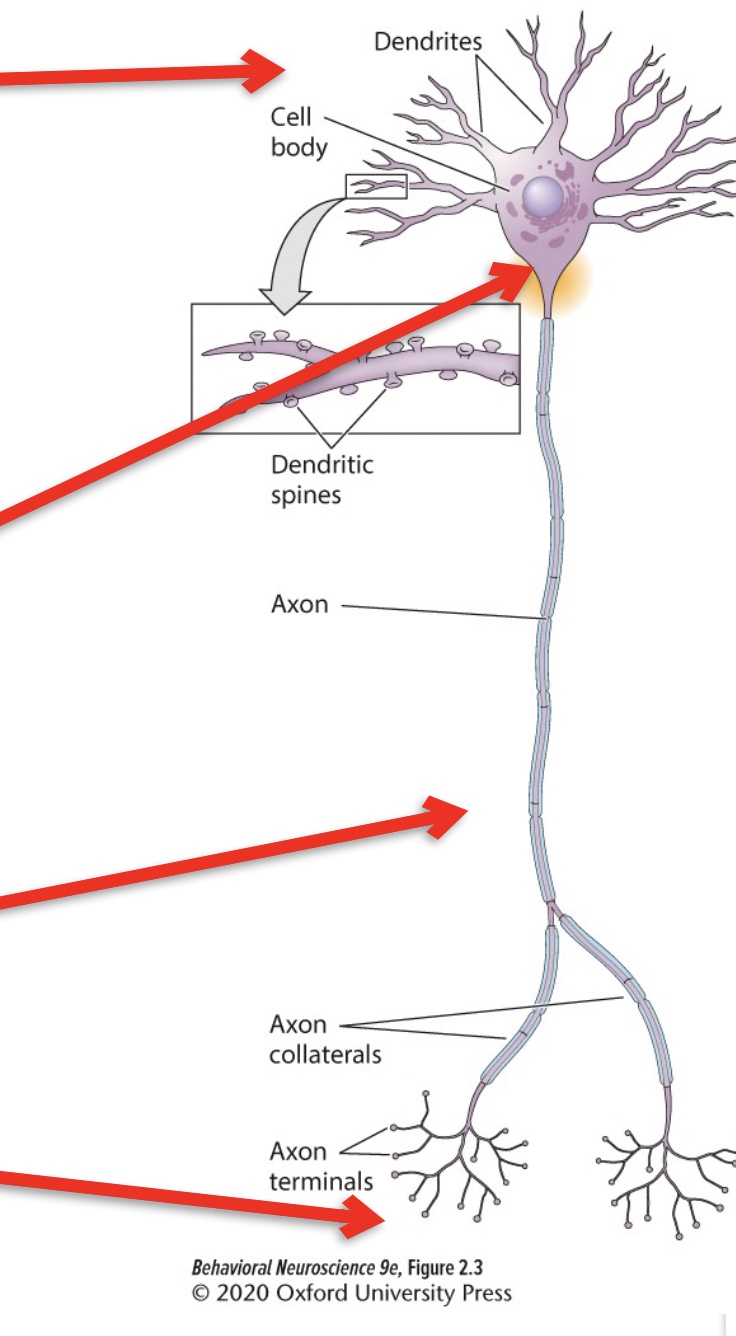
1st arrow
Input zone
26
New cards
Input zone
where neurons **collect and process info**, either from the environment or from other cells (dendrites)
27
New cards
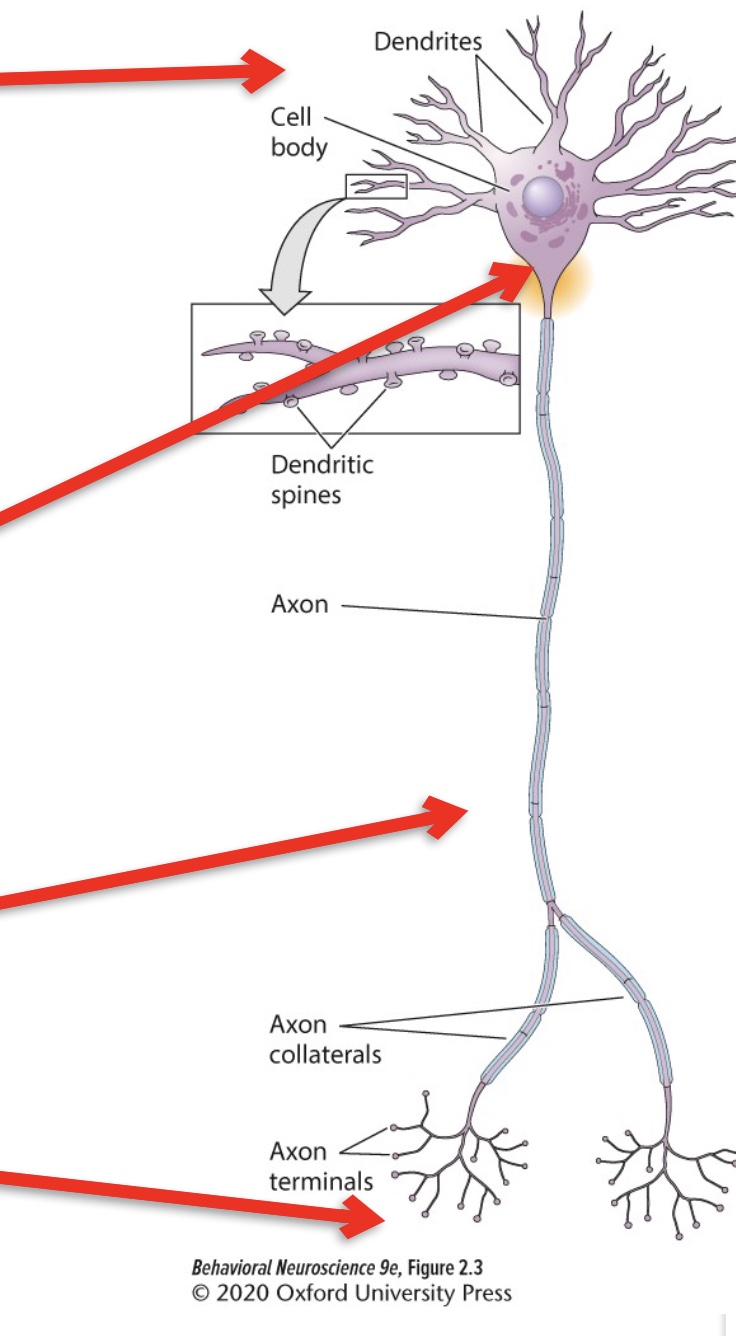
2nd arrow
Integration zone
28
New cards
Integration zone
where the **decision** to produce a neuron signal is made (cell body/axon hillock)
29
New cards
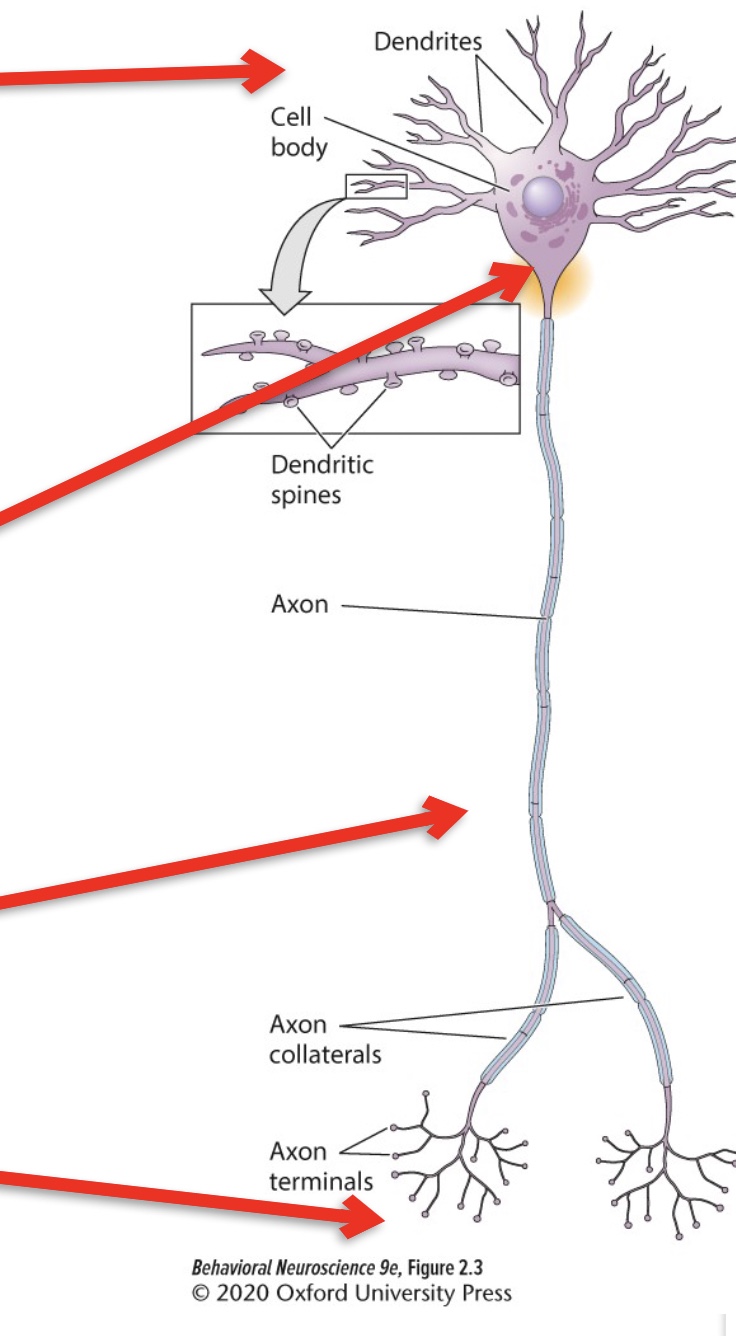
3rd arrow
Conduction zone
30
New cards
conduction zone
(axon) where info can be electrically **transmitted** over great distances
31
New cards
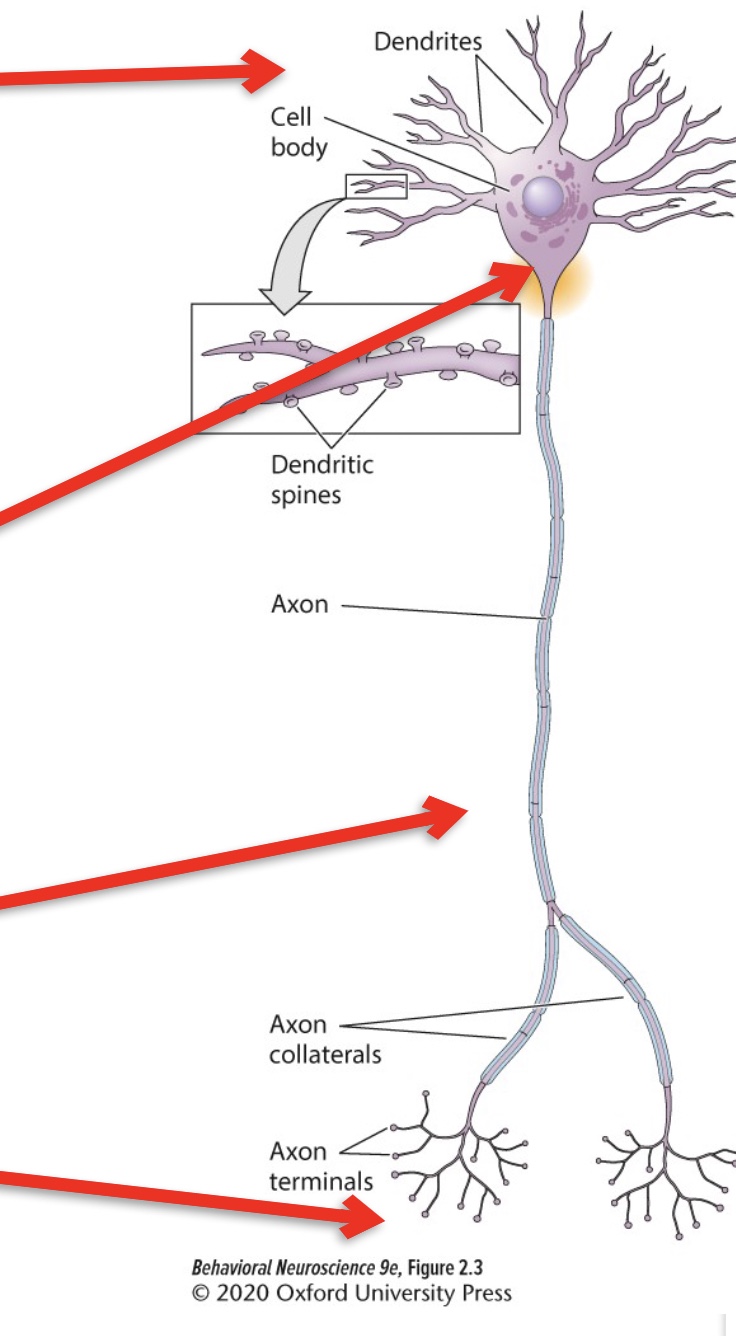
4th arrow
output zone
32
New cards
output zone
where the neuron **transfers** info to other cells (axon terminals; presynaptic neuron)
33
New cards
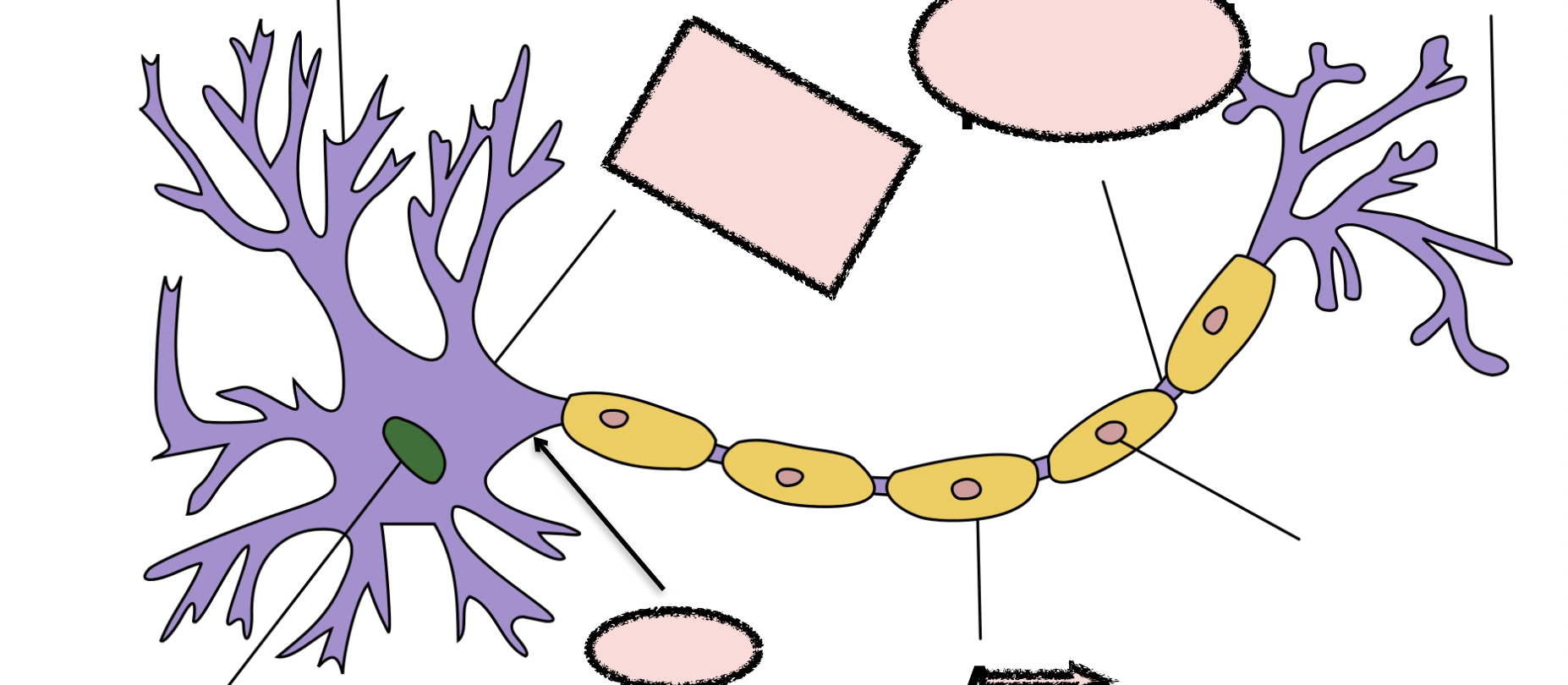
name each part of the neuron
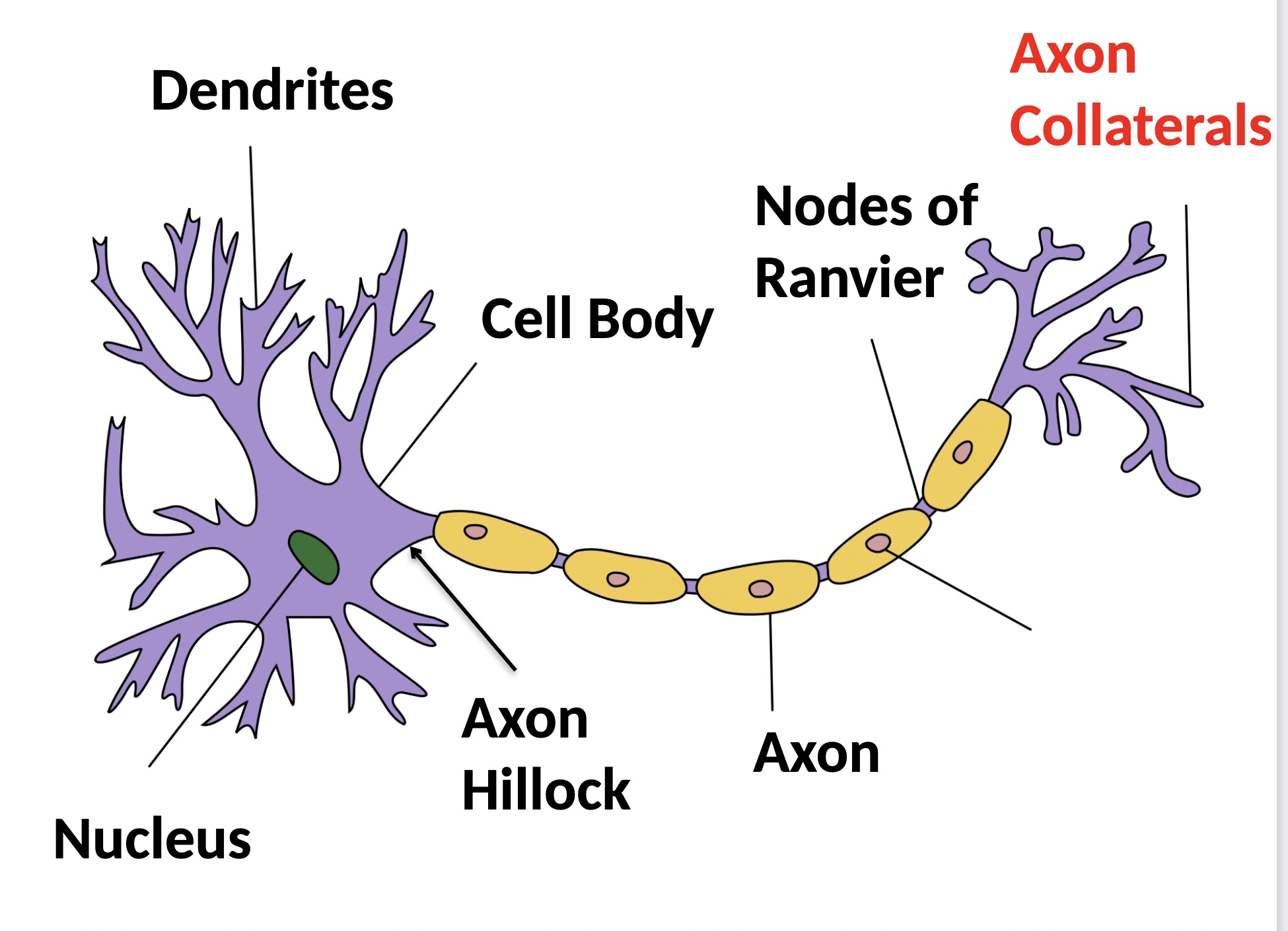
34
New cards
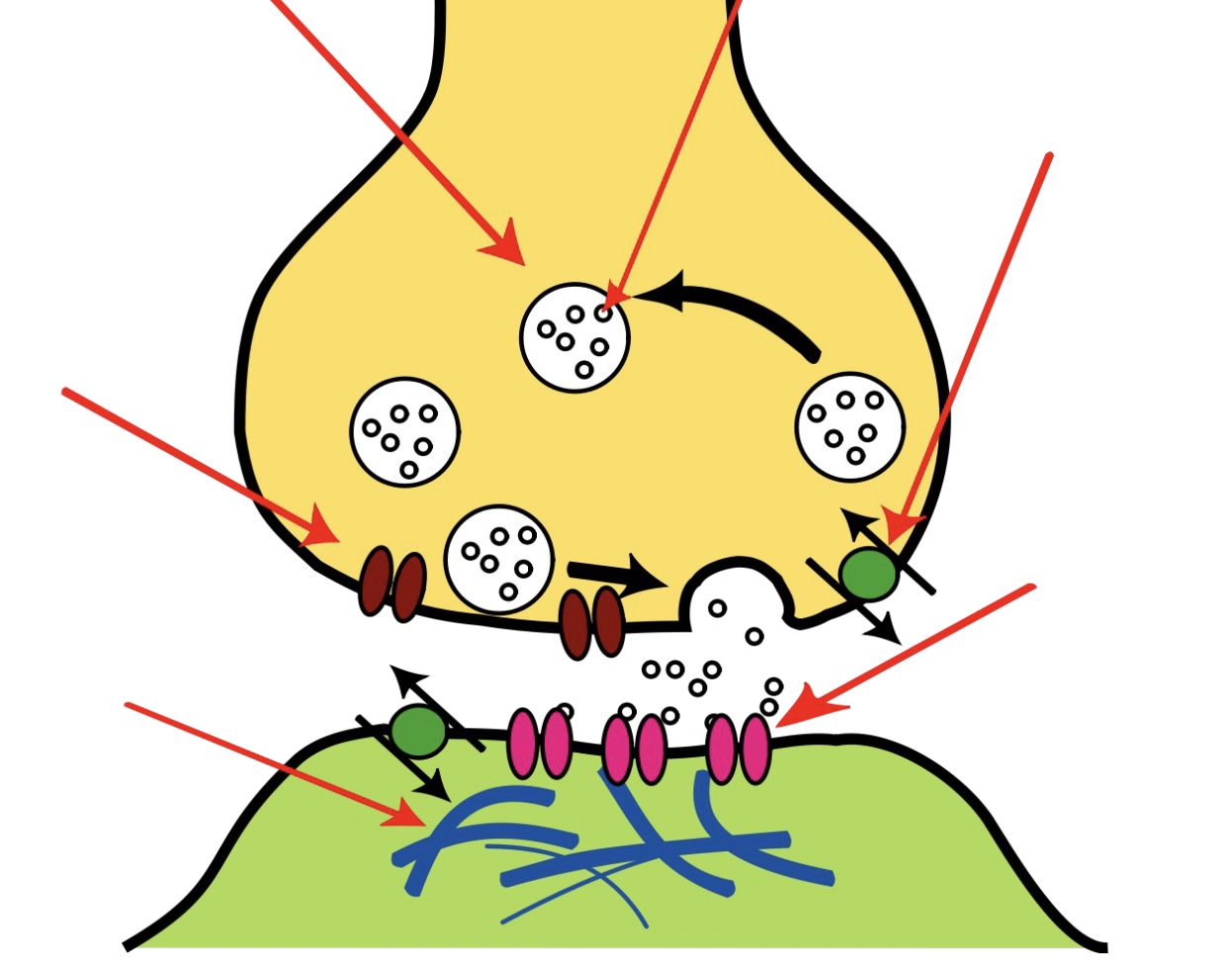
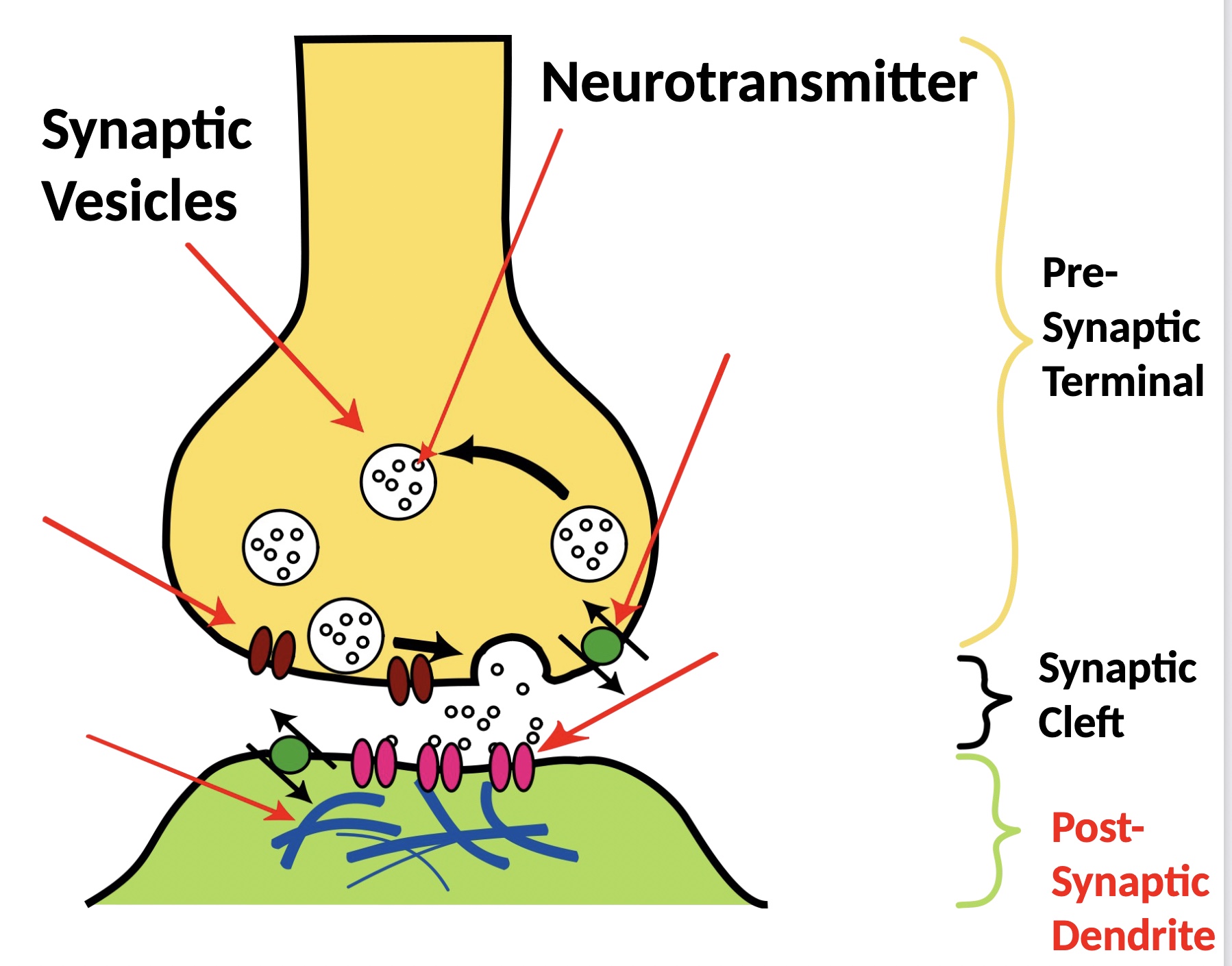
35
New cards
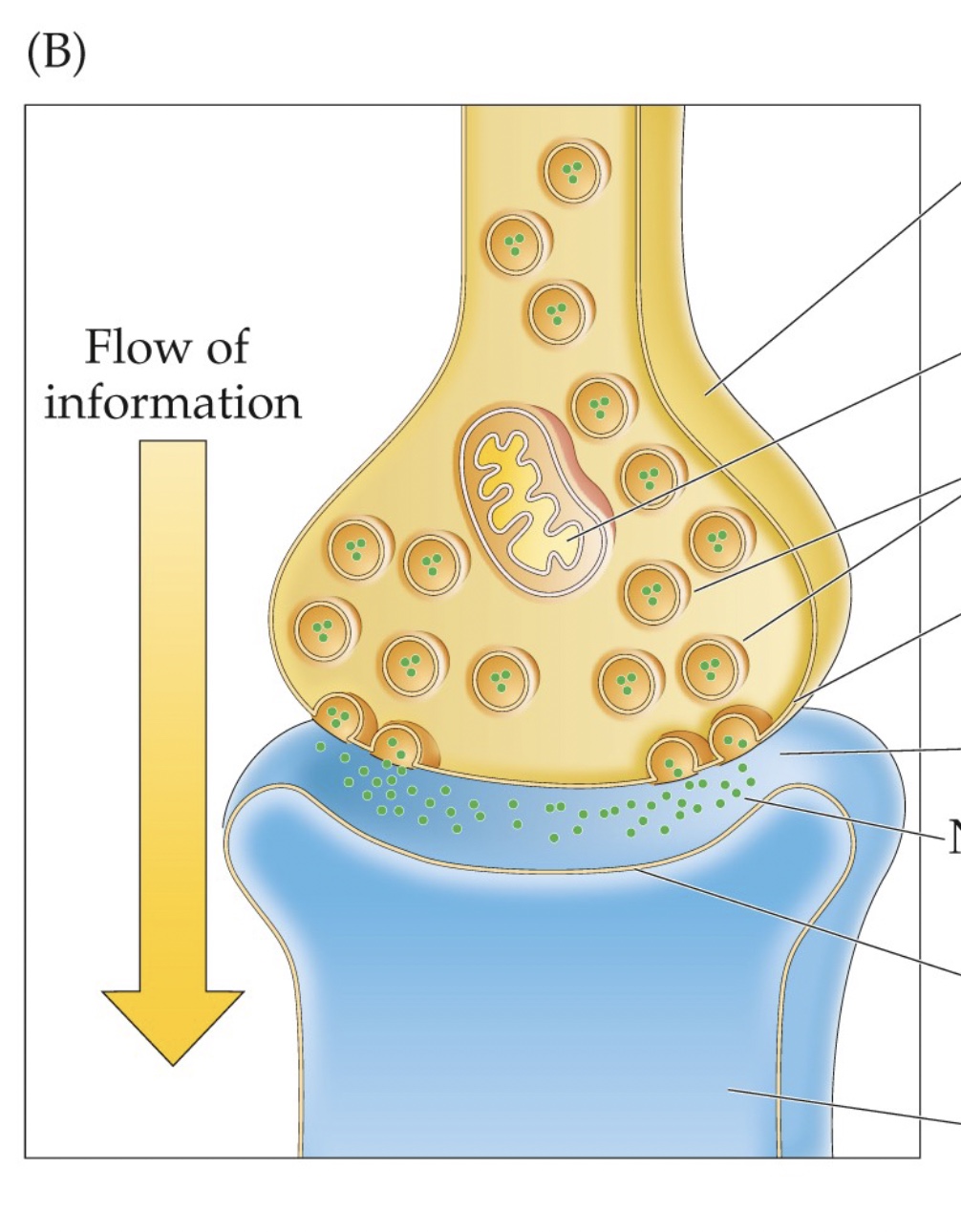
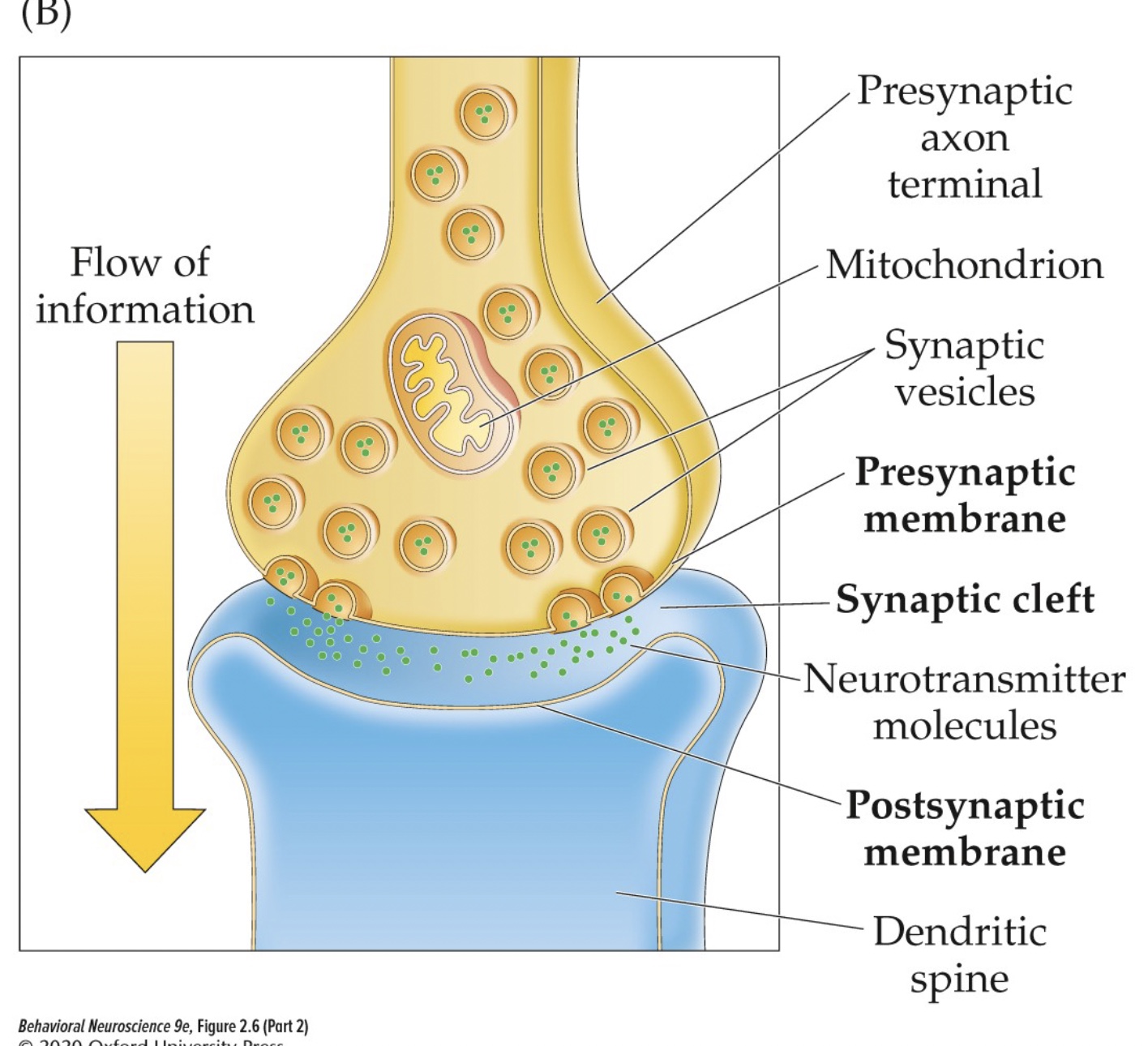
36
New cards
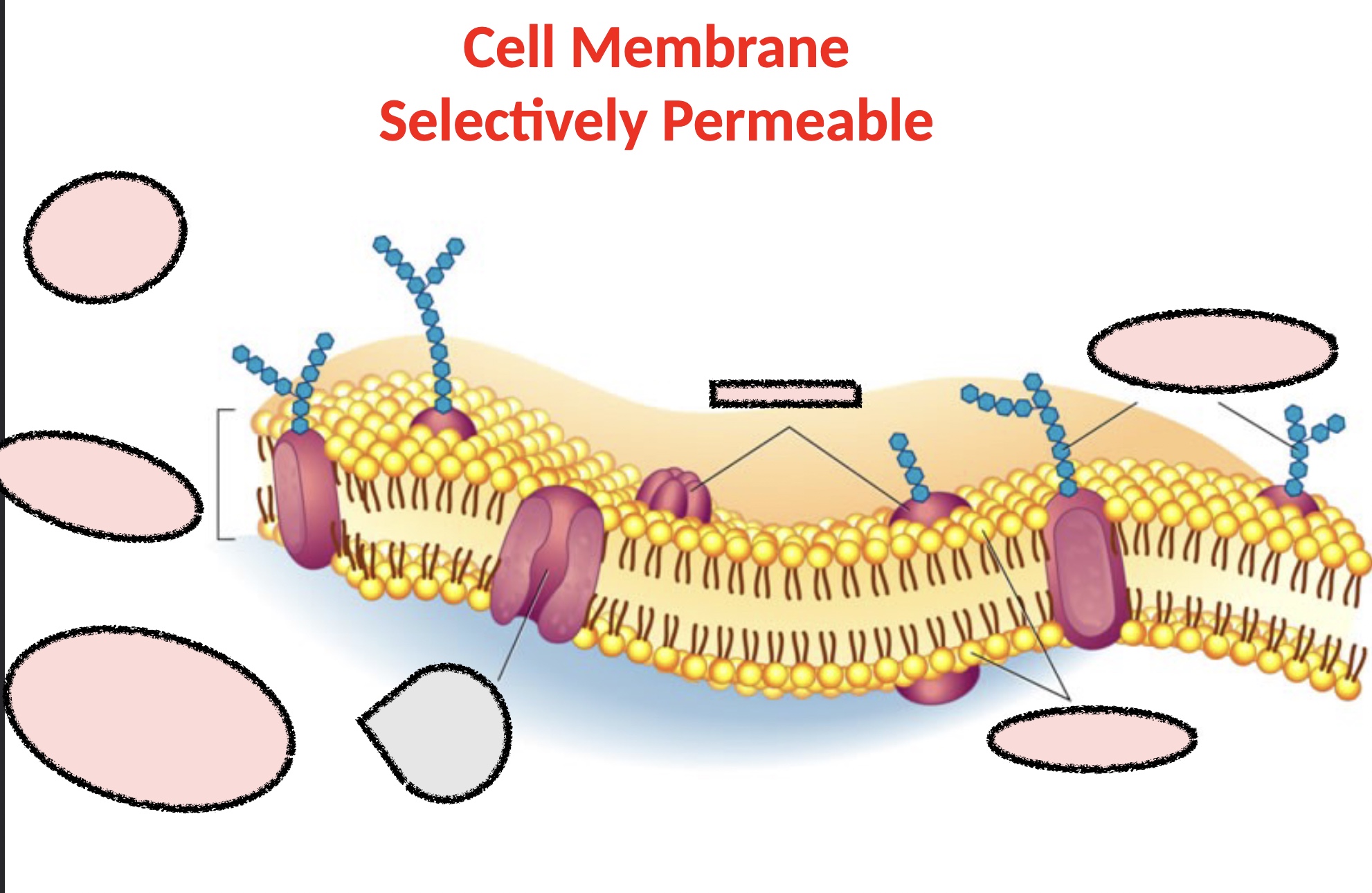
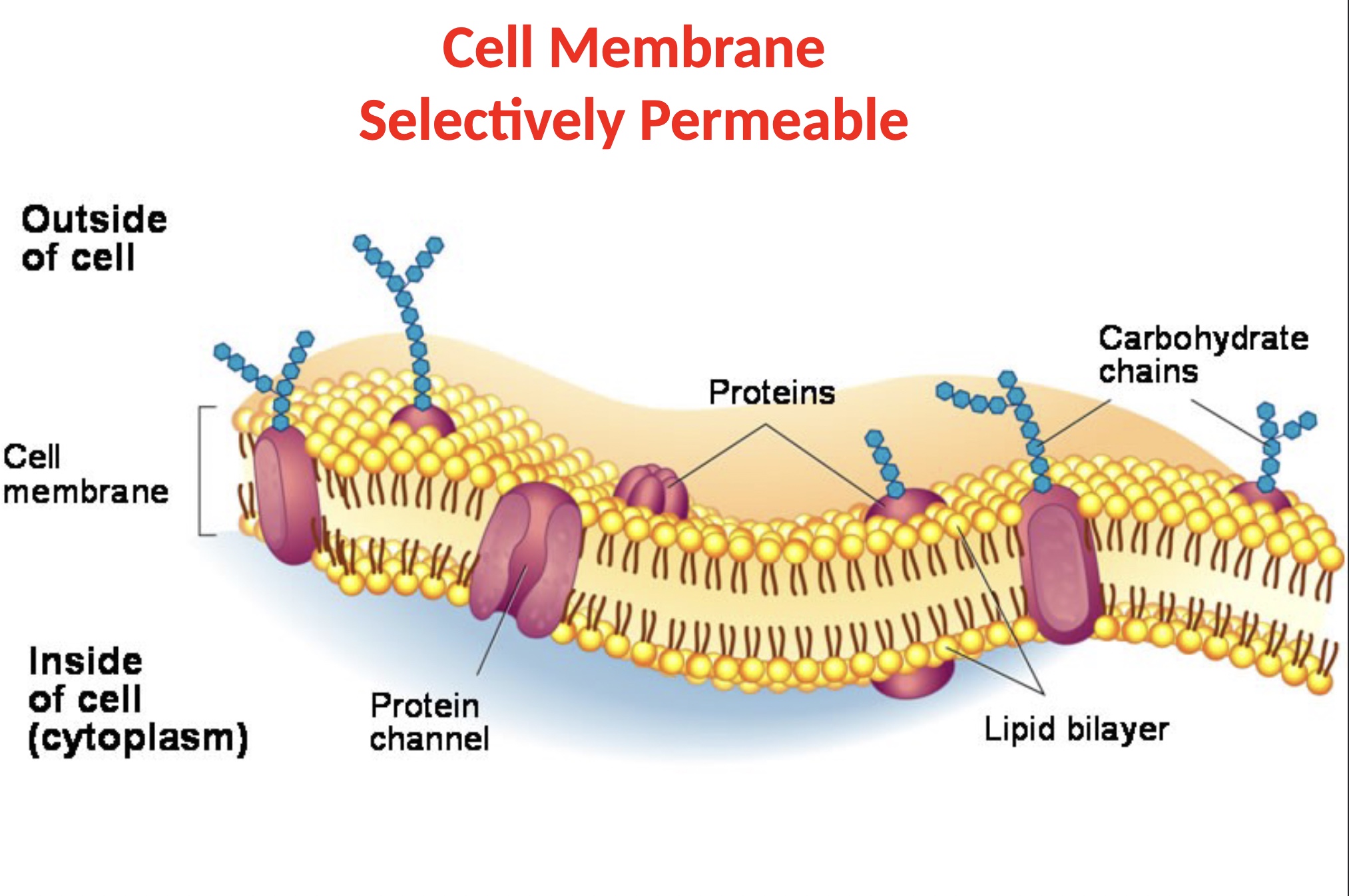
37
New cards
neurons vary in…
size, shape (multipolar, bipolar, unipolar) , and function (sensory, motor, interneuron)
38
New cards
Nucleus (chromosomes)
contain genes encoded in dna
39
New cards
mitocondria
\`produces energy
40
New cards
Ribosomes
Builds protein
41
New cards
Dendrites
Receives info
Dendritic spines increase in surface area and experience changes them (neural plasticity
Dendritic spines increase in surface area and experience changes them (neural plasticity
42
New cards
axon hillock
gathers and integrates info from all the synapses on the dendrites and cell body and converts the info into a code of electrical impulses that carries the neuron’s message down the axon and toward its targets
43
New cards
axon
transmits info
44
New cards
myelin (only vertebrate axons)
fatty insulating substance (makes the axon look like beans)
protects and supports the axon
protects and supports the axon
45
New cards
nodes of ranvier
space between the beads, small uninsulated patches of axon membrane are exposed
46
New cards
axon collaterals
47
New cards
synaptic vesicles
tiny hollow spheres in the presynaptic axon termonal
48
New cards
neurotransmitter
each vesicle contains one which is a specialized chemical substance which the neuron uses to communicate with the postsynaptic neuron
49
New cards
synaptic cleft
transfers info
50
New cards
Post Synaptic Dendrite/Dendritic Spine
receives info (5k-10k contacts)
51
New cards
Receptors
Specialized protein molecules that capture and react to molecules of the neurotransmitter
52
New cards
synapse=
presynaptic terminal membrane + synaptic cleft + postsynaptic neuron membrane
53
New cards
Cell membrane
Lipid Bilayer
Intra and extra cellular fluid
Selectively permeable
Intra and extra cellular fluid
Selectively permeable
54
New cards
Multipolar neurons
many dendrites and a single axon, they are the most common type
55
New cards
Bipolar
Have a single dendrite at one end of the cell and a single axon at the other end. Especially common in sensory systems (EX: vision)
56
New cards
Unipolar / monopolar
single axon that branches in two directions after leaving the cell body. One end input and other end output. Transmits touch info from body to the spinal cord
57
New cards
Afferent
Approach the CNS
58
New cards
Efferent
carry signals away from the CNS
59
New cards
Sensory neurons (afferent)
input: sensory organs contains receptors and adequate stimuli stimulates those receptors
output: synapse onto (communicate with) interneurons
output: synapse onto (communicate with) interneurons
60
New cards
Interneurons
input: receives info from either sensory neurons or other interneurons
output: synapse onto other interneurons or motor neurons
output: synapse onto other interneurons or motor neurons
61
New cards
motor neurons (efferent)
input: receives info from other neurons
output: synapse onto muscles, organs, and glands
output: synapse onto muscles, organs, and glands
62
New cards
Glial cells
contribute to info processing (astrocytes)
removes waste, viruses, fungi from the brain (microglia)
May be involved in pain perception
Builds myelin sheath in vertebrate axons
removes waste, viruses, fungi from the brain (microglia)
May be involved in pain perception
Builds myelin sheath in vertebrate axons
63
New cards
oligodendrocytes
in CNS helps build myelin sheath
More than 75% of the brain’s glial cells are these
More than 75% of the brain’s glial cells are these
64
New cards
Schwann cells
in PNS performs myelination
65
New cards
neurons…
receive, conduct, and transmit info
66
New cards
neurophysiology
The study of chemical and electrical processes in neurons
67
New cards
electrochemical sequence
electrical- within the neuron
chemical- between neurons
chemical- between neurons
68
New cards
Neuron “at rest”
not currently generating an action potential
69
New cards
Properties of a neuron at rest
polarized membrane potential, inside more negatively charged than outside (polarized membrane), resting potential (-50 to -80mV)
70
New cards
ions
electrically charged molecules
71
New cards
anions
negatively charged molecules
72
New cards
cations
positively charged molecules
73
New cards
Forces behind resting membrane potential
unequal distribution of ions (random movement & concentration), electrical gradient-electrostatic pressure-potential homogenizing force, selectively permeable cell membrane and leakage
74
New cards
what happens in a resting potential?
1) Net pressure driving K+ out, minimal resistance to K+ leaving cell the movement causes a difference in charge, counteracting electrostatic pressure is built up
2) Great pressure driving Na+ in high membrane resistance to flow
2) Great pressure driving Na+ in high membrane resistance to flow
75
New cards
why do concentrations remain stable despite homogenizing forces?
\
76
New cards
sodium potassium pump
for every 3 Na+ out two K+ in - maintains concentration gradient
77
New cards
what maintains electrical gradient and polarized membrane?
Negatively charged proteins inside the cell, net loss of positive charge with pump, K+ can leak back out
78
New cards
why isn’t the neuron electrically neutral at rest?
needs to be primed and ready storing up potential energy so that when the signal comes it is ready to be released (bow and arrow)
79
New cards
diffusive force
80
New cards
electrostatic force
81
New cards
In resting potential the cell membrane is selectively permeable to…
potassium (K+)
82
New cards
In a resting potential the diffusive force is…
pushing potassium (K+) out of the cell and the electrostatic force is pushing K+ into the cell
83
New cards
What creates this diffusive force?
The concentration gradient.
84
New cards
Does the concentration gradient produce a diffusive force that outweighs the electrostatic force?
yes
85
New cards
^What does this mean?
The amount of K+ leaving the cell is greater than the amount coming in by the electrostatic force
86
New cards
Passive flow of K+ out of the cell at neuron at rest
Doesn’t require any energy and is just LEAKING out of the cell this means that there is more K+ leaving than is coming in and its leaking out
87
New cards
As potassium leaks out of the cell it is taking positive charges with it and making the inside more negative
Therefore there is a buildup of electrostatic force wanting to push potassium back into the cell and it pushes it back in more and more until it reaches the equilibrium potential
88
New cards
when is the amount of potassium leaving the cell equal to the amount entering? (no net difference)
during the equilibrium potential
89
New cards
Equilibrium Potential
When the diffusive force and the electrostatic force are equal to each other and will no longer change the electrical potential of that particular cell
90
New cards
what maintains the unequal distribution of ions? - sodium more concentrated outside the cell and potassium more concentrated inside the cell
sodium potassium pump
91
New cards
sodium potassium pump
an ion pump where for every 3 sodium ions pumped out 2 potassium ions are pumped in and this helps to maintain the concentration gradient
92
New cards
what maintains this electrical gradient and polarized membrane?
negatively charged proteins inside the cell, with that sodium potassium pump there is a net loss of positive charge every time the pump works - more positive ions leaving cell
93
New cards
is the neuron electrically at rest and if not why?
Its not bc its storing up electrical potential so that when the neuron is ready it can send it’s particular signal
94
New cards
What is an action potential?
a massive momentary reversal of the electrical potential of the membrane from about -60mV to about +40mV that arises in the initial segment of the axon (axon hillock) and is propagated at a high speed along the axon’s length
95
New cards
Depolarization
making the inside of the neuron more positive on the inside. Decreasing the electrical potential between the inside and the outside. Above threshold.
96
New cards
Hyper-polarization
making the inside of the neuron even more negative relative to the outside than at resting state. Increasing the electrical potential between the inside and the outside. Below threshold.
97
New cards
Threshold of excitation
When the depolarization is enough to exceed threshold which allows for an action potential to be produced.
98
New cards
What exactly are the sequence of events resulting in an action potential?
The neuron is at resting potential at -70mV. All of a sudden there is a change in the membrane potential that can get to +40mV! This is a massive momentary reversal of the electrical potential caused by a stimulus such as a depolarizing stimulus, that decreases the electrical potential between the inside and the outside.
99
New cards
what are the 2 necessary conditions for an action potential to occur?
depolarization and exceeding the threshold
100
New cards
what events are taking place during an action potential?
The flow of ions across the membrane through voltage gated channels